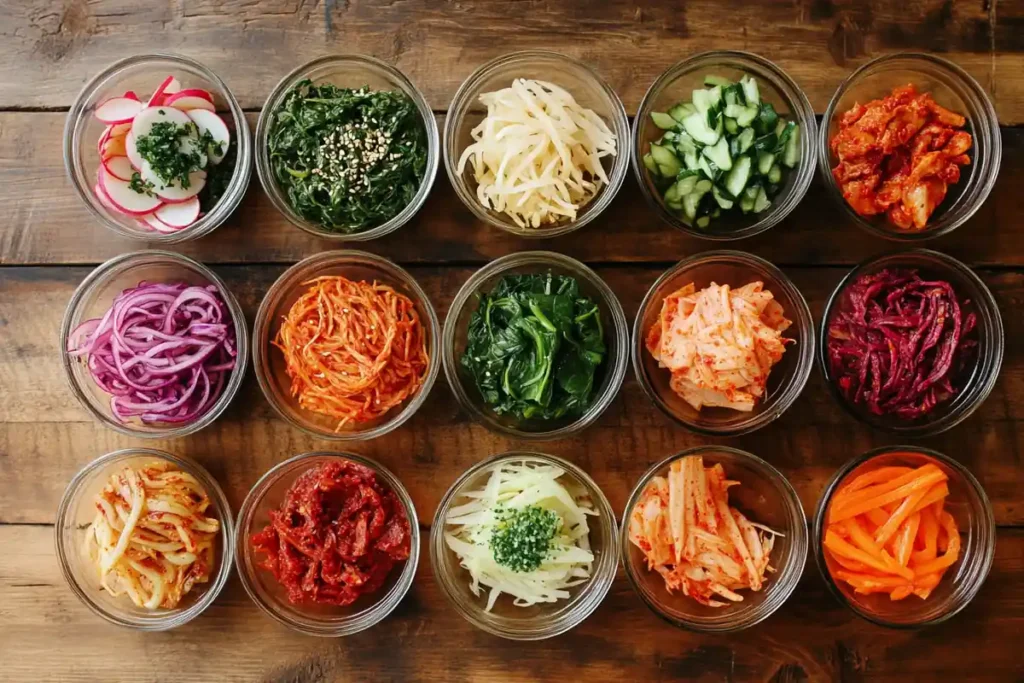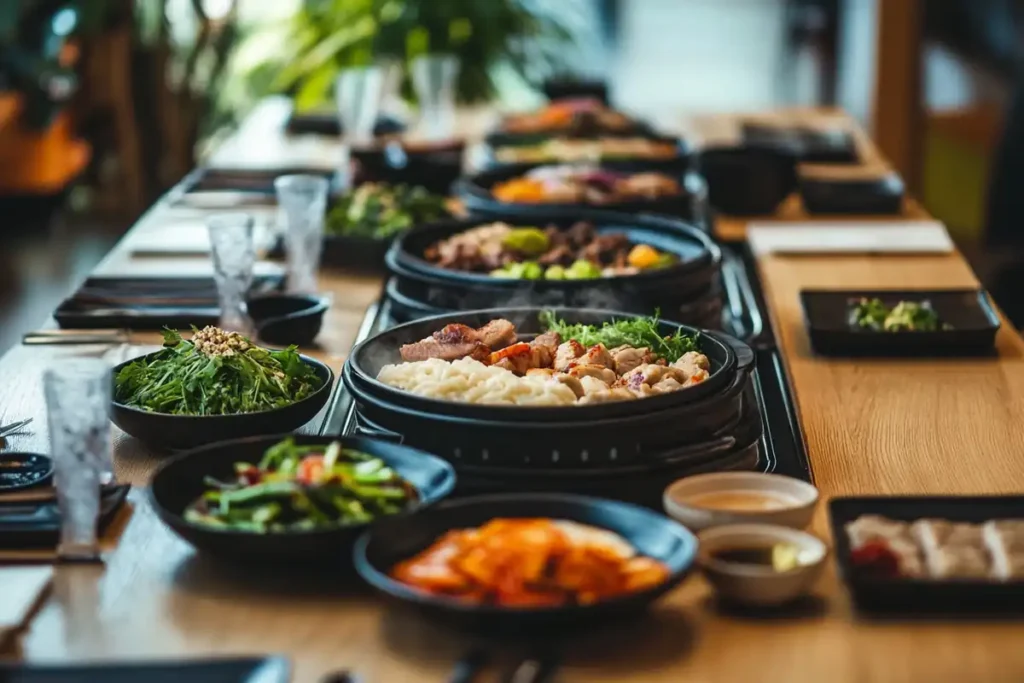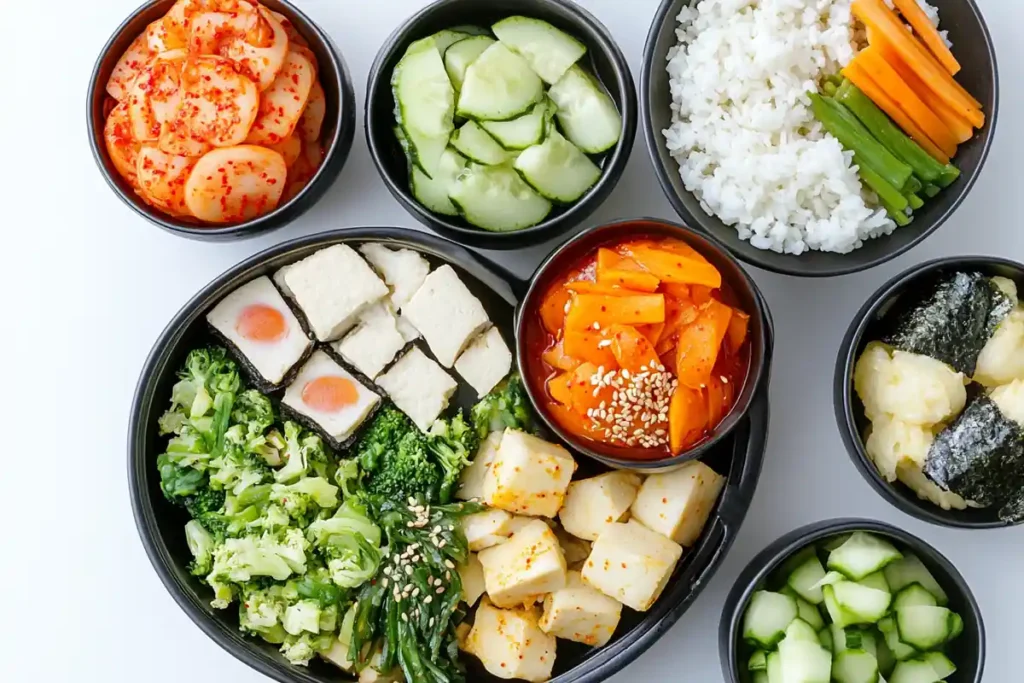A Korean bapsang is far more than just a meal; it’s an intricate tapestry of history, culture, and flavor. Rooted deeply in Korea’s culinary heritage, the bapsang represents harmony and balance in every bite. From perfectly cooked bap (rice) to the symphony of side dishes known as banchan, this dining tradition celebrates variety and aesthetic beauty.
But what sets a bapsang apart? Why is its presentation so revered? In this article, we’ll explore the origins of the bapsang, its unique components, the cultural values it upholds, and how it remains relevant today. Ready to dig in? Let’s start our journey by uncovering its historical roots.
Introduction to the Korean Bapsang
What is a Korean Bapsang?
A bapsang is a traditional Korean dining table setup that features a harmonious balance of flavors, colors, and textures. Its foundation is bap (steamed rice), paired with an assortment of banchan (side dishes), soups, and stews. This intricate setup symbolizes balance—not just in taste but in nutrition and lifestyle.
Unlike Western meals that might revolve around a single main dish, a bapsang invites diners to enjoy a variety of smaller dishes, each playing a role in creating a complete experience. These dishes are meticulously arranged, emphasizing aesthetics and functionality, while reflecting Korea’s communal approach to dining.
Historical Background of Korean Bapsang
The bapsang tradition dates back centuries to Korea’s royal courts and noble households. During the Joseon Dynasty, meals were seen as an art form and a way to honor guests. Every dish served on the bapsang had a purpose, whether to showcase culinary skills, nourish the body, or reflect seasonal changes.
In daily life, however, the common people adapted the idea of bapsang to suit their means. Though simpler than royal feasts, these tables still adhered to the principles of balance and respect for food. Over time, this dining style became a cultural hallmark, bridging generations and social classes.
What Makes a Bapsang Unique?
Several factors make a bapsang stand out:
- Balance of Flavors and Textures: Every meal balances the five primary tastes—sweet, salty, sour, bitter, and spicy. It’s like a party for your taste buds!
- Cultural Symbolism: The setup reflects deep-seated values, like family unity and respect for nature.
- Aesthetic Presentation: In Korean cuisine, how the food looks is just as important as how it tastes. The vibrant colors and orderly arrangement make every bapsang a visual delight.
Beyond these elements, the bapsang serves as a cultural bridge, connecting diners with Korea’s rich history and values. It’s a tradition that thrives in homes, festivals, and even modern restaurants today.
Components of a Korean Bapsang
Rice (Bap): The Foundation of Bapsang
At the heart of every Korean bapsang is bap, or steamed rice. Simple yet essential, bap serves as the foundation of the meal, anchoring the diverse flavors from the accompanying dishes. In Korea, rice isn’t just food—it’s an emotional and cultural staple, symbolizing sustenance and prosperity.
Traditional Korean rice is typically short-grain and slightly sticky, making it perfect for pairing with soups and side dishes. Variations include:
- White Rice (Baekmi Bap): The most common type of rice served in everyday meals.
- Multigrain Rice (Japgokbap): A healthier alternative, mixing white rice with grains like barley, black rice, or beans.
- Nurungji: The crispy, golden rice layer from the bottom of the pot, often enjoyed as a snack or tea.
Rice harmonizes with the other dishes, offering a neutral canvas that highlights the complexity of the flavors around it.
Banchan (Side Dishes): Variety on the Table

If rice is the backbone, banchan is the soul of the bapsang. These small side dishes create a vibrant, diverse spread, providing a mix of textures and tastes that elevate the meal. From tangy to umami-rich, each banchan is a small masterpiece.
Common types of banchan include:
- Kimchi: Fermented vegetables like napa cabbage or radishes, known for their spicy and tangy flavor.
- Japchae: Stir-fried glass noodles with vegetables and soy-based seasoning.
- Namul: Seasoned and sautéed vegetables, such as spinach or bean sprouts.
- Jangjorim: Soy-braised eggs, offering a savory, slightly sweet bite.
The number and variety of banchan can vary depending on the occasion. A humble home meal may feature three or four dishes, while a more elaborate spread can include up to twelve!
Soups and Stews: The Essential Warmth
No bapsang is complete without a steaming bowl of soup (guk) or stew (jjigae). These dishes not only add warmth but also create balance in both flavor and nutrition.
- Doenjang Jjigae: A hearty soybean paste stew with tofu, zucchini, and mushrooms.
- Kimchi Jjigae: A spicy stew made with aged kimchi and tofu.
- Miyeok Guk: Seaweed soup, often eaten on birthdays and special occasions.
Each soup or stew is crafted to complement the rest of the meal, ensuring that no flavor overpowers another.
Proteins in a Bapsang: Meat, Seafood, and Tofu
Proteins bring variety and substance to a Korean bapsang. While plant-based proteins like tofu are common, meat and seafood dishes are also popular, reflecting Korea’s access to both land and sea resources.
Popular protein options include:
- Bulgogi: Marinated and grilled beef slices, offering a sweet and savory flavor.
- Grilled Mackerel: A simple yet flavorful seafood option often found in traditional meals.
- Dububuchim: Pan-fried tofu served with soy dipping sauce, perfect for vegetarians.
The variety ensures that every diner, regardless of preference, finds something to enjoy on the table.
Presentation and Etiquette
The Art of Arranging a Bapsang

Presentation is a hallmark of the Korean bapsang. It’s not just about placing dishes on the table; it’s about creating harmony and balance that reflect Korean values. Each dish has a designated spot, and the overall arrangement aims to provide both visual appeal and convenience for diners.
Key elements of arranging a bapsang include:
- Symmetry and Order: Dishes are placed symmetrically around the central rice bowl, ensuring balance and accessibility.
- Color Coordination: A variety of colors—reds, greens, whites, and yellows—are showcased to symbolize diversity and nutrition.
- Portion Control: Small portions encourage diners to sample everything without overwhelming the table.
This thoughtful arrangement is rooted in tradition, but it also enhances the dining experience by allowing each dish to shine.
Korean Dining Etiquette: Respect at the Table
Dining etiquette is integral to enjoying a bapsang. Koreans value respect and mindfulness, which is evident in their table manners. Whether it’s a casual family meal or a formal gathering, these rules guide the experience:
- Wait for the Elders: It’s customary to let the eldest person at the table take the first bite before others begin eating.
- Use Utensils Properly: Chopsticks are for solid foods, while the spoon is reserved for soups and rice. Never leave chopsticks sticking upright in rice—it’s considered impolite.
- Share the Meal Mindfully: Although the bapsang is communal, each diner serves themselves with care, avoiding excess.
Following these practices not only enhances the meal but also reflects the respect and harmony central to Korean culture.
Modern Adaptations of the Korean Bapsang
While traditional bapsang remains cherished, modern lifestyles and global influences have led to adaptations that make it more accessible.
- Single-Serve Bapsang: Busy urbanites often enjoy simplified versions of the bapsang, featuring fewer dishes but maintaining the spirit of balance.
- Fusion Flavors: Contemporary Korean chefs experiment with global flavors, incorporating ingredients like avocado or quinoa into traditional dishes.
- Restaurant Innovations: Many Korean restaurants abroad offer curated bapsang sets, introducing the tradition to an international audience.
These changes demonstrate the bapsang’s adaptability while preserving its essence. Whether traditional or modern, the bapsang continues to celebrate the beauty of Korean dining.
The Cultural and Nutritional Value
Cultural Symbolism of a Korean Bapsang
A Korean bapsang is more than just a meal; it’s a powerful representation of family, respect, and shared values. In Korea, food has always been a way to communicate care and appreciation, and the bapsang is a heartfelt expression of that tradition.
- Family and Community: Sharing a bapsang is a cherished ritual that strengthens family bonds. Whether it’s a simple breakfast or a celebratory feast, the act of gathering around the table reflects the importance of togetherness. It’s not just about eating; it’s about creating memories and reinforcing connections.
- Seasonal Celebrations: The bapsang takes on special significance during festivals and holidays. On Lunar New Year, for example, the table features symbolic dishes like tteokguk (rice cake soup), believed to bring prosperity and good fortune.
- Respect for Nature: The diverse spread of a bapsang highlights Korea’s reverence for nature’s offerings. Ingredients are often chosen based on the season, emphasizing freshness and sustainability. This deep connection to nature is a key aspect of Korean culture.
Ultimately, the bapsang serves as a bridge between past and present, reminding diners of their cultural roots while encouraging gratitude for the food and those who prepare it.
Health Benefits of a Traditional Bapsang

The bapsang isn’t just a visual and cultural delight; it’s also a nutritional powerhouse that embodies healthy eating principles. The thoughtful balance of dishes ensures that every meal provides a well-rounded combination of essential nutrients.
- Balanced Nutrition: The bapsang incorporates all major food groups: carbohydrates (rice), proteins (tofu, meat, or seafood), and plenty of vegetables. This balance promotes energy, longevity, and overall health.
- Fermented Foods: Staples like kimchi, doenjang (soybean paste), and gochujang (red chili paste) are packed with probiotics that improve digestion, support gut health, and enhance immunity. Fermentation also amplifies flavor, giving the dishes their signature tang and depth.
- Focus on Freshness: Unlike processed meals, a bapsang relies on fresh, seasonal ingredients that retain their nutrients. Vegetables are often lightly cooked or served raw to preserve their natural vitamins and minerals.
- Portion Control: The variety of small dishes encourages mindful eating. Diners can savor a little of everything, reducing the likelihood of overeating and promoting satisfaction with smaller portions.
In a world increasingly focused on health and wellness, the bapsang stands out as a model of balanced and mindful eating. By blending tradition with nutritional wisdom, it offers a timeless approach to nourishing the body and soul.
FAQs
What is the significance of banchan in a bapsang?
Banchan is essential to a bapsang because it introduces variety and balance. These small side dishes are crafted to complement the rice and other main dishes, offering a spectrum of flavors, colors, and textures that reflect the diversity of Korean cuisine.
How is a Korean bapsang different from other Asian dining setups?
While many Asian cultures value communal dining, a Korean bapsang stands out for its emphasis on balance and aesthetics. The variety of banchan, harmonious flavors, and strict adherence to arrangement traditions make it unique.
Can a bapsang be tailored for special dietary needs?
Absolutely! The flexibility of a bapsang allows for adaptations to suit dietary restrictions. Vegetarian options like dububuchim (pan-fried tofu) and namul (seasoned vegetables) are perfect examples of its adaptability.
Why is fermented food important in a bapsang?
Fermented foods like kimchi and soybean paste play a dual role in a bapsang. They enhance flavor while offering significant health benefits, including improved digestion, stronger immunity, and a rich source of probiotics.
How does Korean dining etiquette influence bapsang presentation?
Etiquette emphasizes respect, harmony, and mindfulness, shaping the way dishes are arranged and served. From waiting for elders to take the first bite to the symmetry of the table setup, these traditions reflect the cultural values tied to the bapsang.
Conclusion
The Enduring Charm of a Korean Bapsang
The Korean bapsang is a testament to the beauty of balance, both in its flavors and its cultural significance. Rooted in centuries of tradition, it brings together a rich tapestry of tastes, colors, and textures that celebrate Korea’s culinary heritage. From the comforting simplicity of bap to the vibrant variety of banchan, every element serves a purpose—not just to nourish the body but to connect diners to history, family, and nature.
In today’s fast-paced world, the bapsang continues to evolve, proving its adaptability without losing its essence. Whether enjoyed in a traditional setting, reimagined in modern kitchens, or introduced to new audiences globally, the bapsang remains a cherished symbol of Korean identity.
For those seeking not just a meal but an experience, the bapsang offers a journey into Korea’s heart and soul. After all, it’s more than food—it’s a celebration of harmony, respect, and community that transcends the plate.

